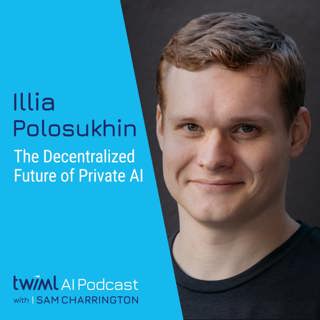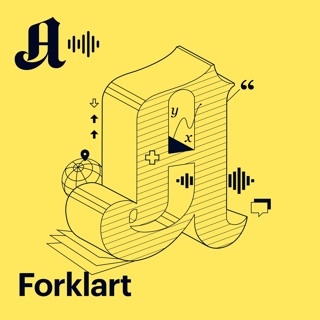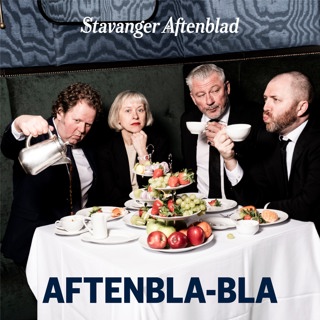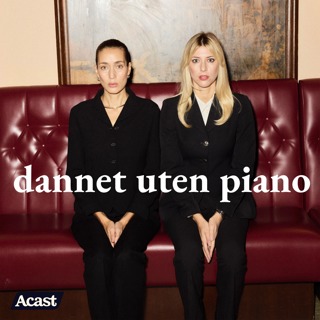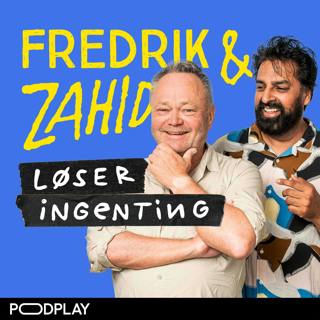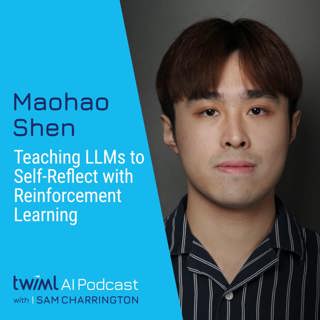
Teaching LLMs to Self-Reflect with Reinforcement Learning with Maohao Shen - #726
Today, we're joined by Maohao Shen, PhD student at MIT to discuss his paper, “Satori: Reinforcement Learning with Chain-of-Action-Thought Enhances LLM Reasoning via Autoregressive Search.” We dig into how Satori leverages reinforcement learning to improve language model reasoning—enabling model self-reflection, self-correction, and exploration of alternative solutions. We explore the Chain-of-Action-Thought (COAT) approach, which uses special tokens—continue, reflect, and explore—to guide the model through distinct reasoning actions, allowing it to navigate complex reasoning tasks without external supervision. We also break down Satori’s two-stage training process: format tuning, which teaches the model to understand and utilize the special action tokens, and reinforcement learning, which optimizes reasoning through trial-and-error self-improvement. We cover key techniques such “restart and explore,” which allows the model to self-correct and generalize beyond its training domain. Finally, Maohao reviews Satori’s performance and how it compares to other models, the reward design, the benchmarks used, and the surprising observations made during the research. The complete show notes for this episode can be found at https://twimlai.com/go/726.
8 Apr 51min
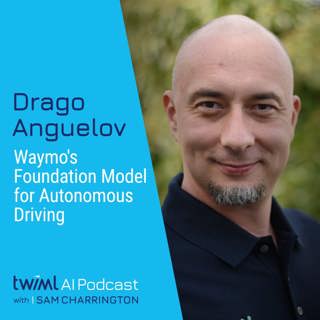
Waymo's Foundation Model for Autonomous Driving with Drago Anguelov - #725
Today, we're joined by Drago Anguelov, head of AI foundations at Waymo, for a deep dive into the role of foundation models in autonomous driving. Drago shares how Waymo is leveraging large-scale machine learning, including vision-language models and generative AI techniques to improve perception, planning, and simulation for its self-driving vehicles. The conversation explores the evolution of Waymo’s research stack, their custom “Waymo Foundation Model,” and how they’re incorporating multimodal sensor data like lidar, radar, and camera into advanced AI systems. Drago also discusses how Waymo ensures safety at scale with rigorous validation frameworks, predictive world models, and realistic simulation environments. Finally, we touch on the challenges of generalization across cities, freeway driving, end-to-end learning vs. modular architectures, and the future of AV testing through ML-powered simulation. The complete show notes for this episode can be found at https://twimlai.com/go/725.
31 Mar 1h 9min
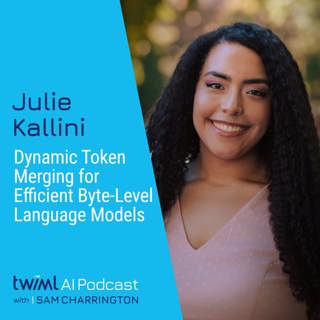
Dynamic Token Merging for Efficient Byte-level Language Models with Julie Kallini - #724
Today, we're joined by Julie Kallini, PhD student at Stanford University to discuss her recent papers, “MrT5: Dynamic Token Merging for Efficient Byte-level Language Models” and “Mission: Impossible Language Models.” For the MrT5 paper, we explore the importance and failings of tokenization in large language models—including inefficient compression rates for under-resourced languages—and dig into byte-level modeling as an alternative. We discuss the architecture of MrT5, its ability to learn language-specific compression rates, its performance on multilingual benchmarks and character-level manipulation tasks, and its performance and efficiency. For the “Mission: Impossible Language Models” paper, we review the core idea behind the research, the definition and creation of impossible languages, the creation of impossible language training datasets, and explore the bias of language model architectures towards natural language. The complete show notes for this episode can be found at https://twimlai.com/go/724.
24 Mar 50min
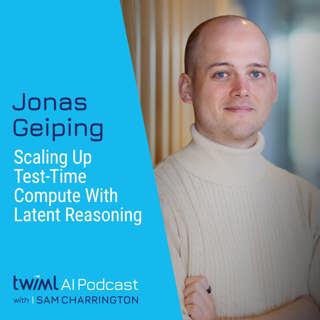
Scaling Up Test-Time Compute with Latent Reasoning with Jonas Geiping - #723
Today, we're joined by Jonas Geiping, research group leader at Ellis Institute and the Max Planck Institute for Intelligent Systems to discuss his recent paper, “Scaling up Test-Time Compute with Latent Reasoning: A Recurrent Depth Approach.” This paper proposes a novel language model architecture which uses recurrent depth to enable “thinking in latent space.” We dig into “internal reasoning” versus “verbalized reasoning”—analogous to non-verbalized and verbalized thinking in humans, and discuss how the model searches in latent space to predict the next token and dynamically allocates more compute based on token difficulty. We also explore how the recurrent depth architecture simplifies LLMs, the parallels to diffusion models, the model's performance on reasoning tasks, the challenges of comparing models with varying compute budgets, and architectural advantages such as zero-shot adaptive exits and natural speculative decoding. The complete show notes for this episode can be found at https://twimlai.com/go/723.
17 Mar 58min
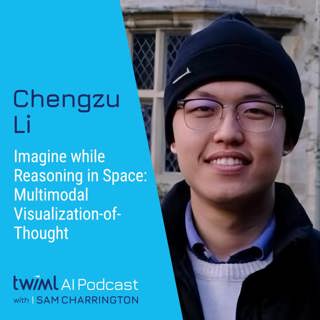
Imagine while Reasoning in Space: Multimodal Visualization-of-Thought with Chengzu Li - #722
Today, we're joined by Chengzu Li, PhD student at the University of Cambridge to discuss his recent paper, “Imagine while Reasoning in Space: Multimodal Visualization-of-Thought.” We explore the motivations behind MVoT, its connection to prior work like TopViewRS, and its relation to cognitive science principles such as dual coding theory. We dig into the MVoT framework along with its various task environments—maze, mini-behavior, and frozen lake. We explore token discrepancy loss, a technique designed to align language and visual embeddings, ensuring accurate and meaningful visual representations. Additionally, we cover the data collection and training process, reasoning over relative spatial relations between different entities, and dynamic spatial reasoning. Lastly, Chengzu shares insights from experiments with MVoT, focusing on the lessons learned and the potential for applying these models in real-world scenarios like robotics and architectural design. The complete show notes for this episode can be found at https://twimlai.com/go/722.
10 Mar 42min
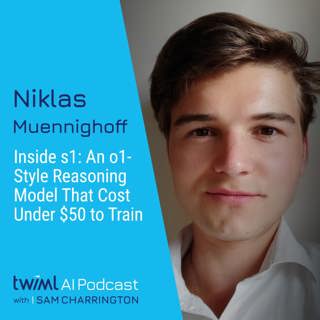
Inside s1: An o1-Style Reasoning Model That Cost Under $50 to Train with Niklas Muennighoff - #721
Today, we're joined by Niklas Muennighoff, a PhD student at Stanford University, to discuss his paper, “S1: Simple Test-Time Scaling.” We explore the motivations behind S1, as well as how it compares to OpenAI's O1 and DeepSeek's R1 models. We dig into the different approaches to test-time scaling, including parallel and sequential scaling, as well as S1’s data curation process, its training recipe, and its use of model distillation from Google Gemini and DeepSeek R1. We explore the novel "budget forcing" technique developed in the paper, allowing it to think longer for harder problems and optimize test-time compute for better performance. Additionally, we cover the evaluation benchmarks used, the comparison between supervised fine-tuning and reinforcement learning, and similar projects like the Hugging Face Open R1 project. Finally, we discuss the open-sourcing of S1 and its future directions. The complete show notes for this episode can be found at https://twimlai.com/go/721.
3 Mar 49min
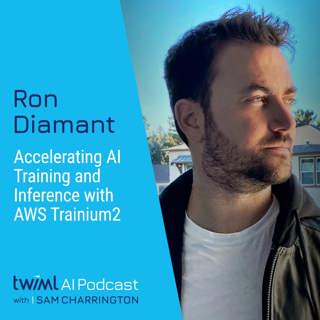
Accelerating AI Training and Inference with AWS Trainium2 with Ron Diamant - #720
Today, we're joined by Ron Diamant, chief architect for Trainium at Amazon Web Services, to discuss hardware acceleration for generative AI and the design and role of the recently released Trainium2 chip. We explore the architectural differences between Trainium and GPUs, highlighting its systolic array-based compute design, and how it balances performance across key dimensions like compute, memory bandwidth, memory capacity, and network bandwidth. We also discuss the Trainium tooling ecosystem including the Neuron SDK, Neuron Compiler, and Neuron Kernel Interface (NKI). We also dig into the various ways Trainum2 is offered, including Trn2 instances, UltraServers, and UltraClusters, and access through managed services like AWS Bedrock. Finally, we cover sparsity optimizations, customer adoption, performance benchmarks, support for Mixture of Experts (MoE) models, and what’s next for Trainium. The complete show notes for this episode can be found at https://twimlai.com/go/720.
24 Feb 1h 7min
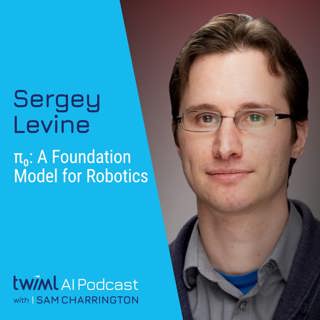
π0: A Foundation Model for Robotics with Sergey Levine - #719
Today, we're joined by Sergey Levine, associate professor at UC Berkeley and co-founder of Physical Intelligence, to discuss π0 (pi-zero), a general-purpose robotic foundation model. We dig into the model architecture, which pairs a vision language model (VLM) with a diffusion-based action expert, and the model training "recipe," emphasizing the roles of pre-training and post-training with a diverse mixture of real-world data to ensure robust and intelligent robot learning. We review the data collection approach, which uses human operators and teleoperation rigs, the potential of synthetic data and reinforcement learning in enhancing robotic capabilities, and much more. We also introduce the team’s new FAST tokenizer, which opens the door to a fully Transformer-based model and significant improvements in learning and generalization. Finally, we cover the open-sourcing of π0 and future directions for their research. The complete show notes for this episode can be found at https://twimlai.com/go/719.
18 Feb 52min
